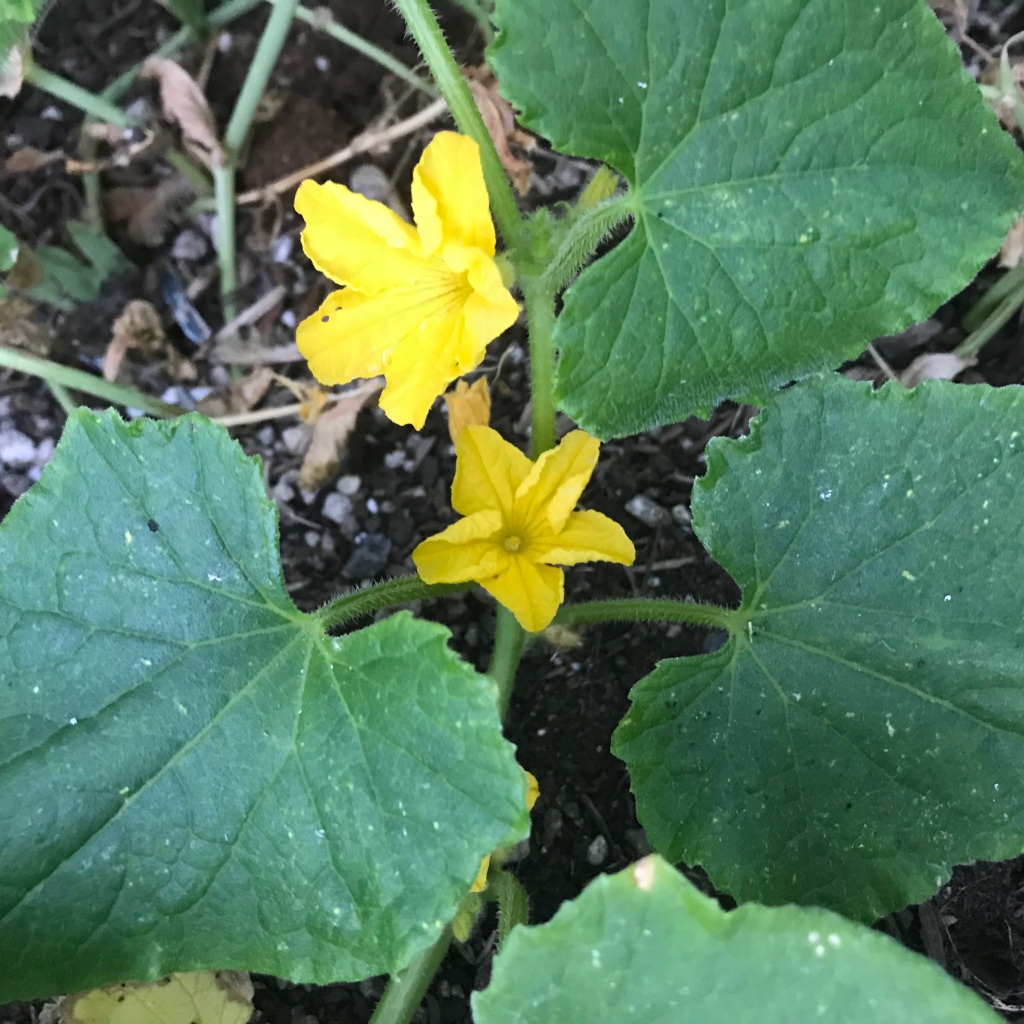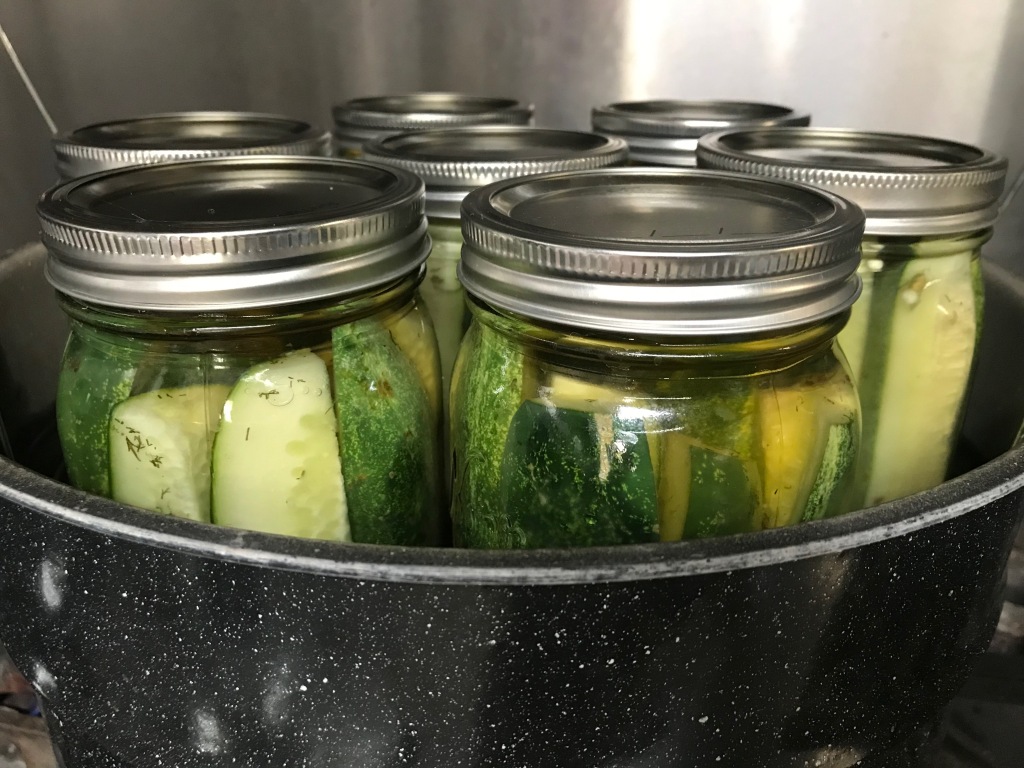THIS POST HAS BEEN MOVED AND UPDATED. Click here for the new post.
You’re welcome to continue reading it here, but the new post is better (and wordpress is going to show you ads on this page–there are no ads on the new post).
This is the #1 question that folks ask Ruby all the time. As we prepare for cucumber season, otherwise known as cucumberpocalypse, we wanted to share Ruby’s advice about how to make your pickles CRUNCHY and CRISPY!
Tip #1: Use Pickling Cucumbers
You’ll want to use pickling cucumbers, not slicing cucumbers (and NOT English cucumbers, the ones that come wrapped individually in plastic – those make terrible pickles!).
The best way to get pickling cucumbers is to grow them yourself, because homegrown is always best and also because they can be expensive and hard to find in stores (usually only for a limited time in late summer). You can also contact local farmers and buy directly from them.
We grow Boston Pickling Cucumbers and one called “Double Yield.” If you’re growing your own, choose a variety that is well-suited for your climate. Harvest them when they are small, the will hold up better in the water bath the smaller they are. Cucumbers like consistent watering, and lots of nutrients, and they need something to climb on like a trellis or stakes.

If you don’t have access to grow your own pickling cucumbers, and you have to buy regular cukes, get the smallest, firmest, and bumpiest ones you can find. The big smooth ones for salads make floppy pickles.
It also helps if you’re using big/seedy cucumbers to slice out the seedy bits (cut into spears, then slice off the seedy bits). This won’t work if you’re making slices/chips – you can’t take out the seedy bits so your chips will probably be floppy. I recommend cutting into spears if all you’ve got to work with are big seedy cucumbers.
FYI, those cute little Persian cucumbers (sometimes called “mini” cucumbers) also hold up nicely and make delicious pickles, especially sweet ones.
Tip #2: Pick & Pickle ASAP
Pickle them as soon as possible after harvesting – this can be tough with store-bought cucumbers, but at least you can try to purchase and pickle in the same day so they aren’t sitting around.
I typically pick and pickle in the same day, and that helps a lot. I think it also improves the flavor and freshness/vitality of the product.

Tip #3: Keep Cold Until It’s Time to Get Hot
I keep cukes refrigerated if I have to hold them for any length of time, and after slicing them, I put them back in the fridge until it’s time to pack the jars. I can’t stress this one enough – it reeeeeallllly helps.
This is especially true especially if you’ve had to bend or break rules #1 and/or #2 (using non-pickling cucumbers, or waiting a while to process them).
You don’t need pickle crisp or alum or any weird chemicals! I don’t personally use grape leaves, but I know a lot of canners who swear by them. Let us know in the comments if you’ve tried using grape leaves, and what your results were like. Our neighbors do have grape vines, so we may try it ourselves this summer…

BONUS TIP: Don’t UnderProcess or OverProcess
It’s important to process the jars for the minimum amount of time based on the content and size of the jars, so please be sure to consult the Ball Blue Book or USDA if you’re unsure of proper canning times. You’ll also need to factor in altitude if you are canning above 1000ft elevation (canning times are longer the higher the elevation, because… science!).
In order to maintain the minimum process time for the size of jar/product inside, without exposing the jars to excess heat/overprocessing, I keep the filled jars in the basket above the water until it’s at a rolling boil, plunge them in when it’s boiling hard (use oven mitts for goodness sake! it’s HOT!), and start the timer immediately. Make sure the waterbath is boiling when you put the jars in it, so you reduce the excess time your pickles spend in the bath as it returns a rolling boil.
To avoid overprocessing, and to allow them to cool quickly, take them out immediately when the timer dings (remove the whole basket, then remove jars from the basket).
You’ll also want to give your jars some space from one another so they cool faster – if the jars cool down slowly (i.e. packed close together they hold heat for longer), there can be seal failures or a bizarre phenomenon called “flat sour” where your pickles have a funny metallic taste (it won’t hurt you but you won’t want to eat them, yuck!). So make sure you have plenty of room to spread your jars an inch or two apart from each other as they cool.
FREE Resource with Safe Canning Guidelines, Processes, and Recipes: USDA Complete Guide to Home Canning

I have used grape leaves in my pickles for over 30 years. Only one time have they not been crisp. Year before last. But they are really spicy so you don’t always notice that they’re not really all that crisp…LOL. Now I’m wondering which of these other rules I broke that year.
LikeLike